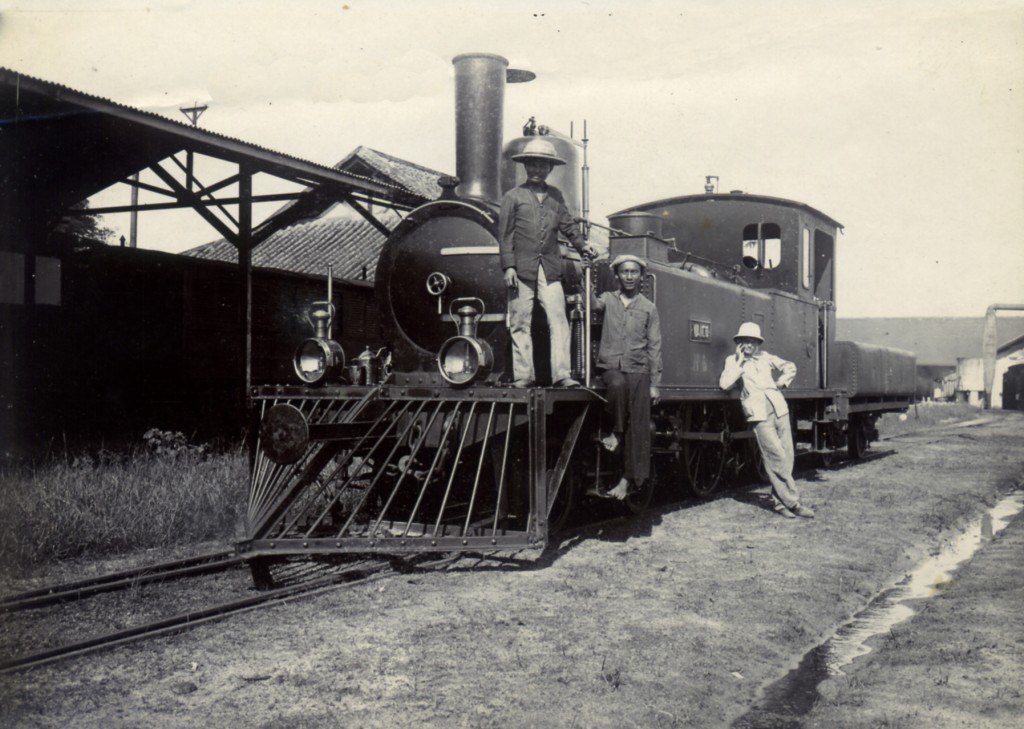
SACM 4-4-0T No. 8 “Vaico” pictured at Sài Gòn Depot
Inaugurated on 20 July 1885, the Sài Gòn-Mỹ Tho line was the first railway line in French Indochina.
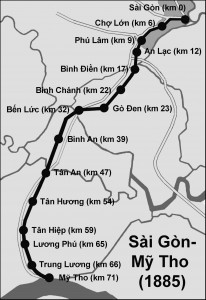
Originally conceived as part of an abortive grand Mekong Delta railway network plan drawn up in 1874, the Saigon-Mỹ Tho line began construction in November 1882, but the project was marred by bitter disputes between the contractor and the colonial authorities – a major bone of contention was the failure of a sub-contractor, the Maison Eiffel, to compensate for track subsidence on marshy ground, leading to serious problems with the access ramps of its three metal viaducts at Bình Điền, Bến Lức and Tân An. Even after the official opening on 20 July 1885, unresolved technical issues with the Bến Lức Bridge meant that a steam ferry was required to convey passengers across the East Vàm Cỏ River for a further 10 months, so that through train services could not be achieved until 29 May 1886.
As with the contemporaneous Saigon-Chợ Lớn “high road” steam tramway, a 1m track gauge was adopted, on the grounds that it could generate significant savings in construction costs by reducing the width of track bed and sleepers and facilitating tighter curves. The line’s tramway-standard 20kg/m rails rendered it suitable only for lightweight rolling stock.
Having cost 11.6 million Francs to build, the line was operated initially as commercial concession involving an annual fee plus a percentage of operating profits. To haul trains on the line, the first concessionaire, Compagnie des chemins de fer garantis des colonies françaises (CCFGCF), acquired five original 0-6-0T locomotives of unknown provenance (Nos 1-5), but these performed badly, and train services were frequently beset by technical problems.
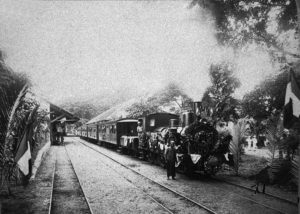
Saïgon-My Thô, le chemin de fer à l’intérieur de la gare (Maison Asie Pacific)
The company’s profits were also impacted negatively by its failure to secure adequate freight business – assumptions that Chinese merchants would switch from barge to rail to transport their rice proved unfounded, rendering the line almost wholly reliant on sporadic and mainly local passenger traffic for its income.
Dissatisfied with the company’s performance, the colonial authorities suspended the franchise in October 1888 and took direct control of the line, pending the identification of a new operator. Eventually on 15 July 1889, the Saigon-Mỹ Tho line was taken over by the Saigon steam tramway operator Société générale des tramways à vapeur de Cochinchine (SGTVC), but only after the colonial authorities had reluctantly agreed to retain responsibility for repairing and maintaining the line’s infrastructure.
SGTVC overhauled the original five 0-6-0T locomotives and equipped them with water tenders to improve their range. Then in 1898, they were supplemented by five new 20.1-tonne SACM Belfort 4-4-0T Locomotives à grande vitesse, capable of speeds of up to 55kph – these were No 7 “Ben-luc,” No 8 “Vaico” and No 11 “Binh-dinh,” delivered in 1896, and No 9 “Tan-an” and No 10 “Mekong,” delivered in 1898. A rail spur from the Saigon-Mỹ Tho line to the main Saigon port complex in Khánh Hội (now District 4) via a new swing bridge was also achieved in 1903.
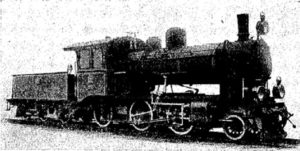
In 1928, five new 22-tonne Orenstein & Koppel 2-6-0 “Moguls” (Nos 21-25) were acquired for the line
In 1911, realising that the annual cost to the government of track, bridge and signalling maintenance and upgrading far outweighed the income it obtained from the franchise holder, the authorities terminated the SGTVC franchise, so that with effect from 1912, the Saigon-Mỹ Tho line became an integral component of the Réseaux non concedes (Non-conceded networks), the network of railway lines operated directly by the Government General of Indochina later known as Chemins de fer de l’Indochine (CFI).
In 1928, five new 22-tonne Orenstein & Koppel 2-6-0 “Moguls” (Nos 21-25) were acquired in lieu of German war reparations. Although these locomotives were ordered exclusively for the Saigon-My Tho line, in practice they were also used on other CFI lines around Saigon.
During the 1930s, when competition from road transportation began to impact seriously on passenger numbers and revenue, the authorities responded by substituting lightweight Renault ABH-2 300hp diesel railcars for steam locomotive-hauled passenger trains.
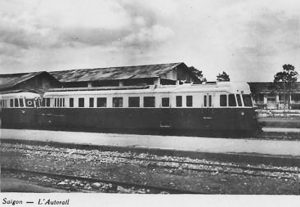
Second-generation Renault ABH-7 300hp diesel railcars at Saigon Station in the mid 1950s
During the First Indochina War, the French military began using the branch to move men and equipment in their campaign against southern revolutionary bases. On several occasions, Việt Minh forces responded by inflicting serious damage on the line’s track and bridges, but on each occasion repairs were carried out swiftly and the line remained open for the duration of the conflict.
By the 1950s, the road network in the Mekong Delta had expanded significantly. Lacking investment, the dilapidated line was increasingly unable to compete with faster trucks and motor coaches. With losses mounting, the South Vietnamese Department of Railways (Sở Hỏa xa Việt Nam, HXVN) opted for closure. The last train from Sài Gòn to Mỹ Tho ran on 30 June 1958.
However, that wasn’t quite the end of the story. The railway track from Sài Gòn to Chợ Lớn (km 6) and Phú Lâm (km 8) remained in place after 1958 and continued to function intermittently as a local freight spur until at least 1970.
Tim Doling is the author of The Railways and Tramways of Việt Nam (White Lotus Press, Bangkok, 2012) and also gives talks on Việt Nam railway history to visiting groups.
A full index of all Tim’s blog articles since November 2013 is now available here.
Join the Facebook group Rail Thing – Railways and Tramways of Việt Nam for more information about Việt Nam’s railway and tramway history and all the latest news from Vietnam Railways.
You may also be interested in these articles on the railways and tramways of Việt Nam, Cambodia and Laos:
A Relic of the Steam Railway Age in Da Nang
By Tram to Hoi An
Date with the Wrecking Ball – Vietnam Railways Building
Derailing Saigon’s 1966 Monorail Dream
Dong Nai Forestry Tramway
Full Steam Ahead on Cambodia’s Toll Royal Railway
Goodbye to Steam at Thai Nguyen Steel Works
Ha Noi Tramway Network
How Vietnam’s Railways Looked in 1927
Indochina Railways in 1928
“It Seems that One Network is being Stripped to Re-equip Another” – The Controversial CFI Locomotive Exchange of 1935-1936
Phu Ninh Giang-Cam Giang Tramway
Saigon Tramway Network
Saigon’s Rubber Line
The Changing Faces of Sai Gon Railway Station, 1885-1983
The Langbian Cog Railway
The Long Bien Bridge – “A Misshapen but Essential Component of Ha Noi’s Heritage”
The Lost Railway Works of Truong Thi
The Mysterious Khon Island Portage Railway
The Railway which Became an Aerial Tramway

